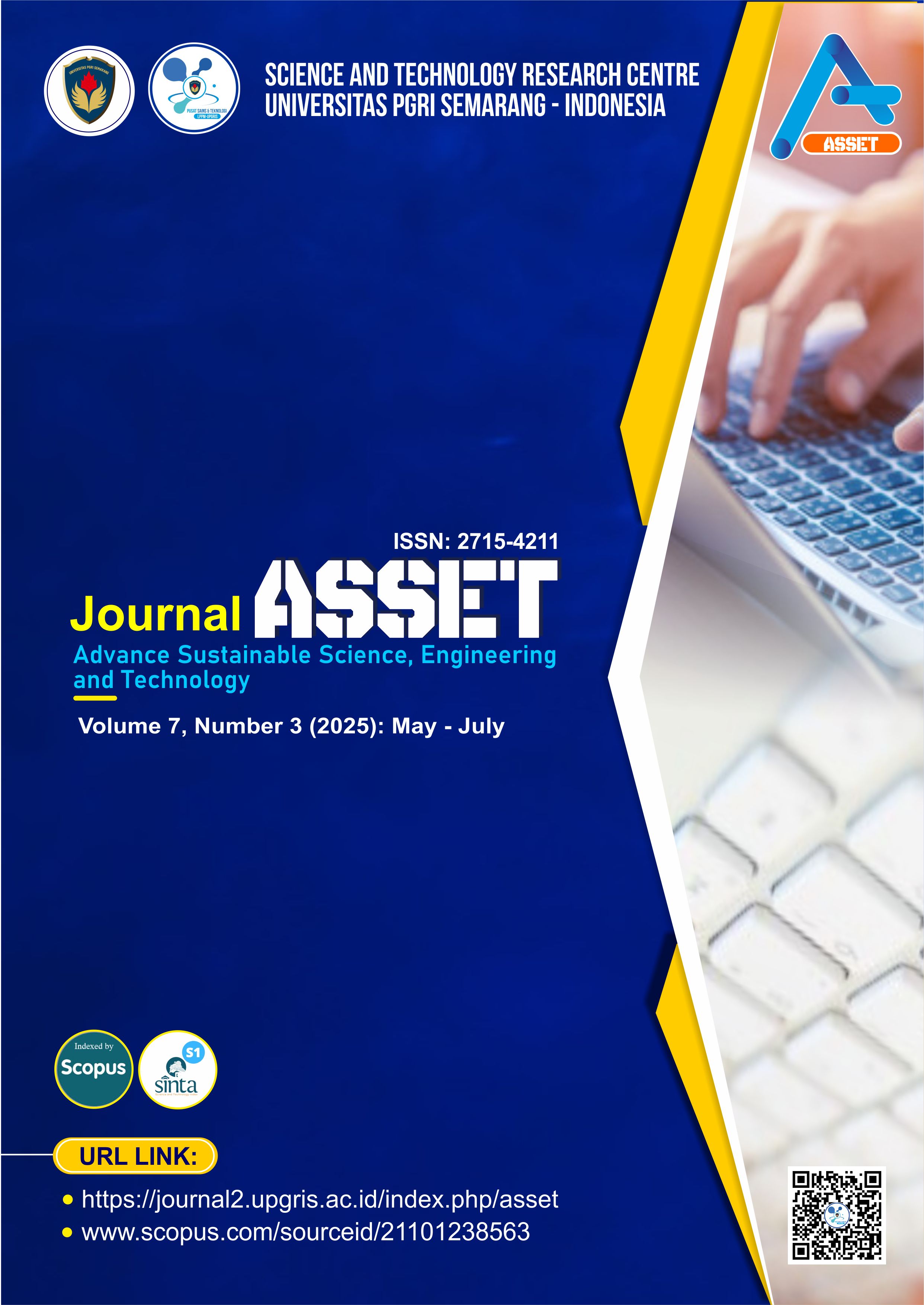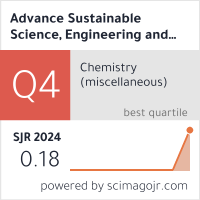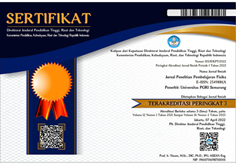Empirical Analysis of the Impact of Labor Coefficients on Column Reinforcement Productivity in Construction Projects
DOI:
https://doi.org/10.26877/asset.v7i4.2590Keywords:
Column Reinforcement Productivity, Construction Projects, Labor CoefficientAbstract
Construction productivity, particularly in column reinforcement, is significantly influenced by labor as a key project component. Variations in labor coefficients determine efficiency in time, cost, and work quality, necessitating empirical analysis of their impact on productivity. This study examines the relationship between labor coefficients and column reinforcement productivity to improve construction project management efficiency. Using a quantitative approach with purposive sampling, 33 observation data were collected through field measurements and questionnaires from workers and foremen. Simple linear regression was applied to test labor coefficient significance, with results compared against PUPR Ministerial Regulation No. 8 of 2023 standards. Analysis revealed that field labor coefficients significantly affect column reinforcement productivity (p < 0.001), demonstrating that optimal labor utilization increases productivity. The comparison with ministerial standards evaluated field condition conformity with official provisions. The research hypothesis confirming significant influence between field labor coefficients and column reinforcement productivity was accepted, providing valuable insights for construction management practices.
References
[1] H. T. H. Gohar, “DIGITAL TRANSFORMATION OF CONSTRUCTION PLANNING IN SAUDI ARABIA’S GIGA PROJECTS: DRIVING VISION 2030 THROUGH SMART DELIVERY MODELS”.
[2] S. G. Naoum, “Factors influencing labor productivity on construction sites: A state-of-the-art literature review and a survey,” International journal of productivity and performance management, vol. 65, no. 3, pp. 401–421, 2016.
[3] G. C. Hartono and T. Octavia, “Analisa Pengaruh Keterlambatan dan Ketidakakuratan Data Laporan Hasil Opname terhadap Pembayaran Gaji Tukang dalam Proyek Konstruksi,” Jurnal Dimensi Insinyur Profesional, vol. 3, no. 1, pp. 35–40, 2025.
[4] N. Kartika, S. M. Robial, and A. Pratama, “Analisis produktivitas tenaga kerja pada pekerjaan kolom di proyek pembangunan gedung Pemda Kabupaten Sukabumi,” Jurnal Momen Teknik Sipil, vol. 3, no. 2, pp. 103–112, 2021.
[5] L. Leuhery, L. M. Saleh, and Y. H. Rakidjan, “Analisa Perbandingan Rencana Anggaran Biaya Pembangunan Parapet Hulu Proyek Upgrading Cek Dam Rinjani Dan Kolam Retensi Dengan Menggunakan Metode BOW, SNI 2016 Dan AHSP 2022,” Manumata: Jurnal Ilmu Teknik, vol. 10, no. 2, pp. 172–179, 2024.
[6] K. R. Amalia and S. Suryani, “Analisis Perbandingan Produktivitas Tenaga Kerja Lokal Dengan Tenaga Kerja yang Didatangkan Dari Luar Kota Jambi,” Jurnal Talenta Sipil, vol. 4, no. 1, pp. 66–73, 2021.
[7] X. Dong, K. Guo, G. Xue, Y. Yang, W. Xie, and C. Liu, “Environmental regulation, resource misallocation, and total factor productivity: an empirical analysis based on 284 cities at the prefecture-level and above in China,” Int J Environ Res Public Health, vol. 20, no. 1, p. 854, 2023.
[8] Y. D. Wei, “Decentralization, marketization, and globalization: The triple processes underlying regional development in China,” Asian Geogr, vol. 20, no. 1–2, pp. 7–23, 2001.
[9] S. Zhang and F. Xie, “Can new quality productivity promote high-quality agricultural development?--an Empirical Study Based on Provincial Panel Data in China,” Front Sustain Food Syst, vol. 9, p. 1601227, 2025.
[10] Sugiyono, Qualitative Research Methods. Bandung: Alfabeta, 2018.
[11] N. Nurhaswinda et al., “Tutorial uji normalitas dan uji homogenitas dengan menggunakan aplikasi SPSS,” Jurnal Cahaya Nusantara, vol. 1, no. 2, pp. 55–68, 2025.
[12] N. M. Janna and H. Herianto, “Konsep uji validitas dan reliabilitas dengan menggunakan SPSS,” 2021.
[13] G. Anuraga, A. Indrasetianingsih, and M. Athoillah, “Pelatihan pengujian hipotesis statistika dasar dengan software r,” BUDIMAS: Jurnal Pengabdian Masyarakat, vol. 3, no. 2, pp. 327–334, 2021.
[14] D. McNeish, “Psychometric properties of sum scores and factor scores differ even when their correlation is 0.98: A response to Widaman and Revelle,” Behav Res Methods, vol. 55, no. 8, pp. 4269–4290, 2023.
[15] A. M. Jarkas, “Critical investigation into the applicability of the learning curve theory to rebar fixing labor productivity,” J Constr Eng Manag, vol. 136, no. 12, pp. 1279–1288, 2010.
[16] Y. Yao, W. Cai, Z. Zhou, and Y. Zheng, “Integration of manufacturing and services: Examining its effect on resource allocation and manufacturing labor productivity,” International Review of Financial Analysis, vol. 96, p. 103708, 2024.
[17] V. B. Ayoola et al., “Optimizing Construction Management and Workflow Integration through Autonomous Robotics for Enhanced Productivity Safety and Precision on Modern Construction Sites,” International Journal of Scientific Research and Modern Technology (IJSRMT), vol. 3, no. 10, 2024.
[18] D. Lee, S. Lee, N. Masoud, M. S. Krishnan, and V. C. Li, “Digital twin-driven deep reinforcement learning for adaptive task allocation in robotic construction,” Advanced Engineering Informatics, vol. 53, p. 101710, 2022.
[19] X. Chen et al., “Implementation of technologies in the construction industry: a systematic review,” Engineering, Construction and Architectural Management, vol. 29, no. 8, pp. 3181–3209, 2022.
[20] M. F. Asa and M. R. Julian, “COMPARISON OF COST BUDGET ANALYSIS BETWEEN THE 2016 AHSP METHOD, AHSP 2022 METHOD AND THE CONTRACTOR’S CALCULATION METHOD ON THE WARUNG JATI RESTAURANT PROJECT, BEKASI CITY,” DEARSIP: Journal of Architecture and Civil, vol. 4, no. 02, pp. 134–147, 2024.
[21] M. Javadi, Z. Raeisi, and A. Bohlool, “The impact of blockchain technology on supply chain production strategies,” Journal of Business and Management Studies, vol. 7, no. 4, pp. 103–118, 2025.
[22] J. BECKWITH, S. GOLDRICK, W. NIXON, and S. KOURTZIDIS, “A Quantitative Methodology to evaluate the cost of Human Capital acquisition. BioPharma Industry Model.,” Journal of HRM, vol. 28, no. 1, 2025.
[23] N. Van Tam, N. Quoc Toan, D. Tuan Hai, and N. Le Dinh Quy, “Critical factors affecting construction labor productivity: A comparison between perceptions of project managers and contractors,” Cogent Business & Management, vol. 8, no. 1, p. 1863303, 2021.
[24] T. Lutzkendorf et al., “IEA EBC Annex 72: Benchmarking and target-setting for the life cycle-based environmental performance of buildings: Energy in Buildings and Communities Technology Collaboration Programme,” 2023.
[25] J. Pu et al., “Sensor-independent LAI/FPAR CDR: reconstructing a global sensor-independent climate data record of MODIS and VIIRS LAI/FPAR from 2000 to 2022,” Earth System Science Data Discussions, vol. 2023, pp. 1–29, 2023.
[26] A. Ibrahim, T. Zayed, and Z. Lafhaj, “Enhancing construction performance: A critical review of performance measurement practices at the project level,” Buildings, vol. 14, no. 7, p. 1988, 2024.











